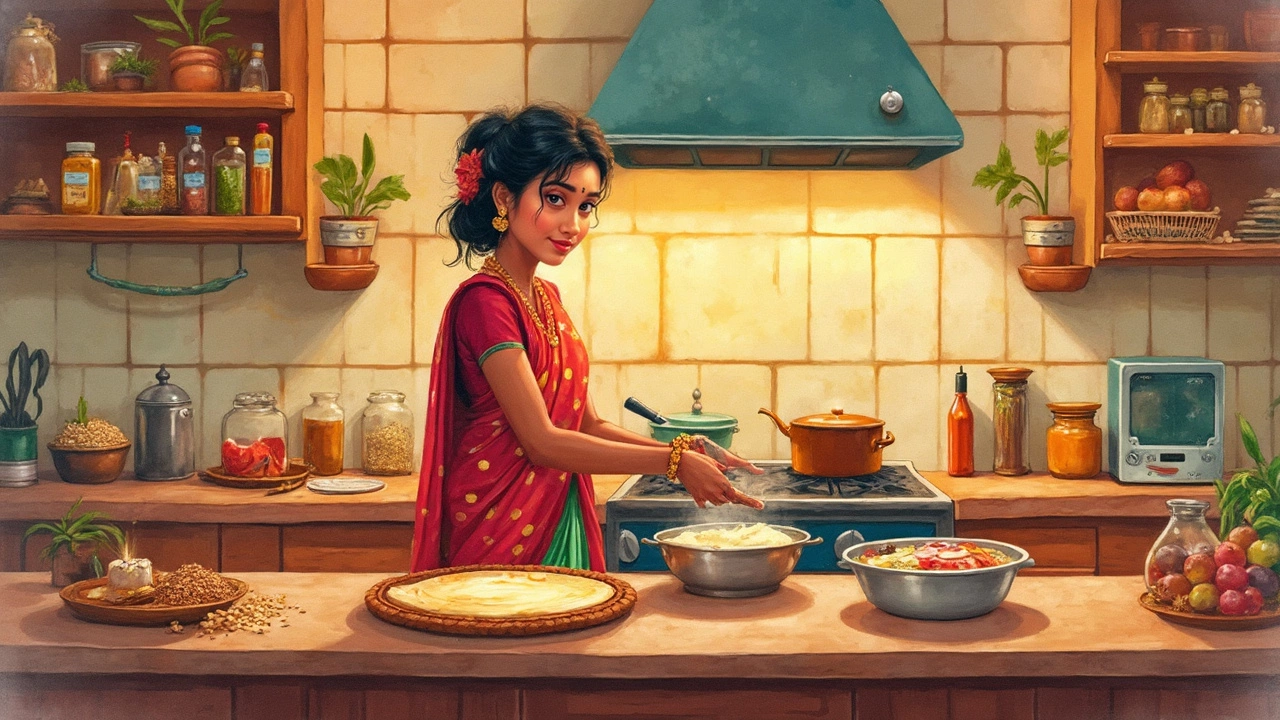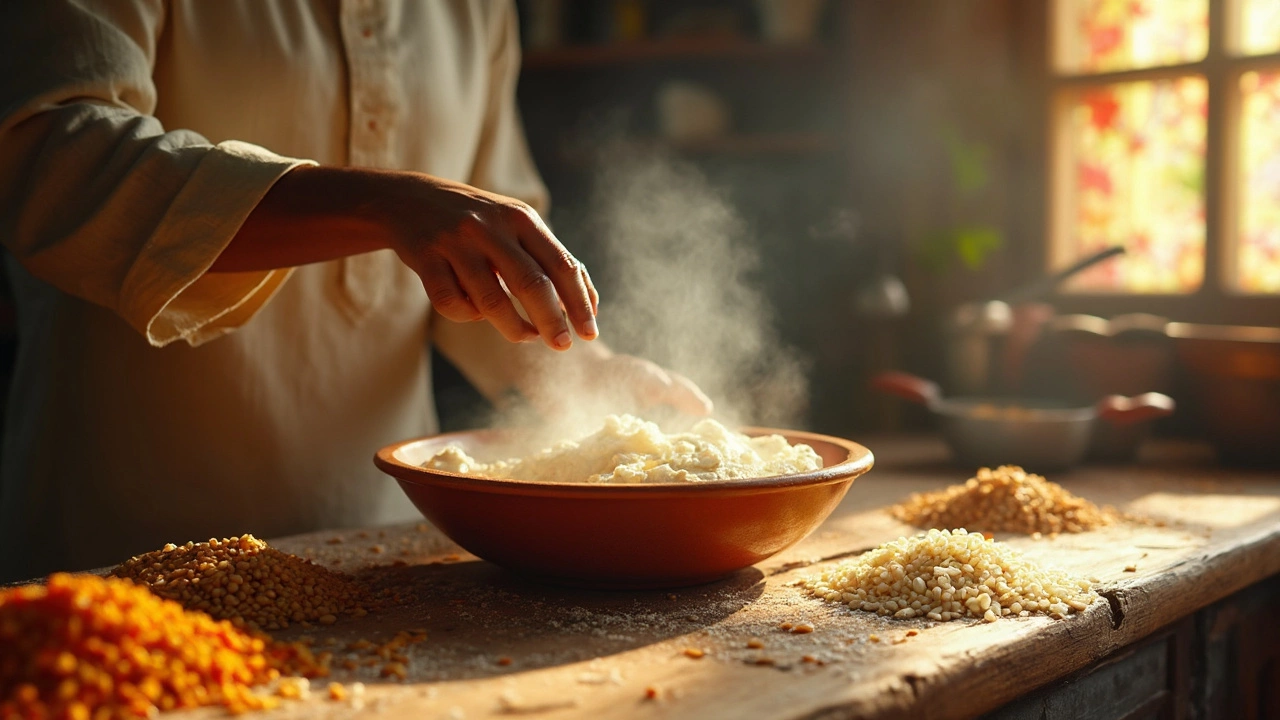Fast Dosa Batter Fermentation: Tips You Need to Try
 Feb, 18 2025
Feb, 18 2025
Who doesn't love a crispy dosa with the right amount of fluffiness? But sometimes, waiting for that batter to ferment can feel like watching paint dry. So, how about some shortcuts to get you cooking dosas faster without losing any taste?
Firstly, let's talk about temperature. Fermentation loves warmth. A simple trick is to leave your batter near a warm spot – maybe on top of a fridge or close to your microwave after running it. And if you're lucky enough to have a yogurt maker or an oven with a fermentation setting, you're already ahead in the game!
- Understanding Fermentation Basics
- Smart Use of Kitchen Gadgets
- Ingredient Hacks for Speed
- Temperature and Environment Tips
- Common Mistakes to Avoid
Understanding Fermentation Basics
So, what’s really happening when you’re fermenting your dosa batter? It's all about those friendly microorganisms like bacteria and yeast getting to work. These little guys break down the sugars in the rice and lentils, producing gas and acids that create the tangy flavor we love.
Why Fermentation Matters
Fermentation isn't just about taste—it also improves the nutritional value. The process increases the level of B vitamins and makes the dosa easier on your gut. A study highlighted in food science journals even shows that fermentation can enhance protein digestibility by breaking down amino acids.
Time is Key
Traditional fermentation can take anywhere from 8 to 12 hours. The process is influenced by factors like temperature, humidity, and even the type of urad dal you use. Higher temperatures generally speed up the process. But, if it gets too hot, you might sour things too much.
Ingredients' Role
Your choice of ingredients can heavily influence how to ferment dosa batter quickly. The proportion of rice to dal typically stands at a 3:1 ratio. Some people swear by adding a teaspoon of methi seeds (fenugreek) to help the fermentation process because it acts like a catalyst.
Keeping an eye on the grain quality is critical too. Fresh dal and rice tend to ferment quicker than those sitting around for months. They have more natural yeast on their surfaces, which kick-starts the fermentation.
Common Fermentation Myths
One myth is that fermentation won’t happen in cooler climates. Not true. You can still ferment in colder places by using your oven’s light or wrapping the batter in a warm towel. People also think you need sugar to get things going. Save your sugar for chai—it's not necessary!
Understanding these basics not only helps with a faster process but also ensures you don't accidentally make your batter too sour or overly thick. So next time you set out to make dosas, remember, it’s as much about the science as it is about skill.
Smart Use of Kitchen Gadgets
Ever thought your kitchen gadgets could become your new best friends in the quest for quick dosa fermentation? With a bit of creativity, you can leverage your appliances to cut down on waiting time without sacrificing the taste.
Oven with Light
Here’s a nifty trick. If you have an oven with a light, it can mimic a perfect fermentation environment. Just switch on the oven light and place the dosa batter bowl inside (don't turn the oven on). The slight warmth from the bulb can help speed up the fermentation process.
Hot Box or Electric Yogurt Maker
A hot box or an electric yogurt maker is another great option. These appliances are designed to maintain a steady warm temperature, which is just what quick dosa tips might include. If you have one, use it to your advantage when time is tight.
Rice Cooker on Warm Mode
Our good old rice cooker isn’t just for rice! Once the rice’s done cooking, the warm setting keeps it just cozy enough. Place your batter dish inside when it's on this mode. Remember, it should just be warm, not hot.
Microwave Boost
Your microwave can give the batter a slight temperature boost. Place a cup of hot water inside and shut the door. This creates a warm environment. Keep your batter bowl next to it, and you’ll see it fermentation speed up.
Playing around with these appliances can get you those mouth-watering dosas in record time. Try these out and see which one works best for your kitchen!

Ingredient Hacks for Speed
When it comes to quick dosa tips, the right ingredients can change the game. Not only do they influence the taste, but, used wisely, they can also speed up the fermentation process.
Add a Pinch of Fenugreek
Fenugreek seeds aren't just for flavor. A teaspoon can really boost the fermentation speed of your dosa batter. These little seeds help in faster bacterial growth, which is exactly what you need.
Use Flattened Rice (Poha)
Adding a handful of poha when you're grinding your batter can work wonders. This trick adds softness to your dosa while also helping in better fermentation. Plus, it's great for achieving that golden brown crispy finish.
Experiment with Lentils
Though traditional dosa uses urad dal, adding a little bit of moong dal to the mix can quicken things up. Moong dal ferments quicker and can add a unique nuttiness to the flavor. Just don’t overdo it, or you might alter the texture more than you'd like.
Natural Magic of Yeast
If you're really pressed for time, a little bit of yeast can be your best friend. A quarter teaspoon of active dry yeast can speed up the process significantly. How to ferment dosa batter faster? Well, ensuring that the yeast is evenly distributed in the batter is key. Just dissolve the yeast in some warm water and add it to your mixture after grinding.
Think About Sugar
It might sound counterproductive, but a touch of sugar can help speed up fermentation. The sugar gives the bacteria something extra to munch on, making them more active. Don't worry, this won’t make your dosa taste sweet.
So, next time you're working on a tight schedule, remember these hacks. They’ll make sure your batter is ready to go with minimal fuss, bringing you closer to that delicious and crunchy dosa much faster.
Temperature and Environment Tips
Speeding up dosa fermentation can really be all about making your kitchen a cozy little paradise for those bacteria. They love warmth, and the right environment can make all the magic happen sooner than you think.
Use Your Oven as an Incubator
Your kitchen oven could be the key player here. No, you don't need to turn it on, but the residual warmth can work wonders! After cooking, while your oven is still warm (but off), place the batter inside with the light on. This maintains just the right cozy temperature that your batter craves.
The Microwave Hack
This one's neat! Pop your bowl of batter inside the microwave, and next to it, place a cup of warm water. Close the door and let the trapped warmth and humidity accelerate the process. It's like a mini sauna for your batter!
Temperature Table
Here's a quick guide on ideal temperatures for dosa fermentation:
| Condition | Temperature (°C) |
|---|---|
| Natural Fermentation | 26-32 |
| Oven with Light | 32-35 |
| Microwave with Warm Water | 30-33 |
Strategic Placement
Sometimes, it's about finding that secret spot! The top of the fridge is often a sweet spot. Why? Well, the back of your fridge stays warm thanks to the compressor, and this gentle heat can be perfect for overnight fermentation.
Dosa fermentation is part science, part instinct. With these temperature and environment hacks, you should be on your way to faster, tastier dosas in no time. Happy cooking!

Common Mistakes to Avoid
When you're in a hurry to get that dosa fermentation just right, it's easy to trip over a few common pitfalls. Let’s sidestep some of those together.
Using Old Ingredients
The quality of your ingredients affects fermentation. Freshly bought urad dal and rice ensure the best fermentation. Avoid using whole grains that have been sitting unloved in your pantry. They’ve probably lost some of their zing.
Too Much Water
Another biggie is going overboard with water while grinding the batter. A watery mix won’t give you the best results. Aim for a thick, cake-like batter consistency. If not, you might end up with runny flat things instead of those delicious dosas.
Ignoring the Ambient Temperature
Many skip thinking about the room temperature. But, it plays a big role. If it's winter, you might need to wrap up your batter bowl with a cloth or place it in a cozy spot. During summer, it's like fermentation on steroids—so keep an eye out!
"Patience and a watchful eye resolve more issues than mere speed can." - A Wisdom from Grandma's Kitchen
Checking Fermentation at the Wrong Time
A lot of folks get jumpy and check the batter too soon. It's tempting, but give it those peaceful 8 hours. Poking around can mess with the good bacteria doing its magic.
Avoid these bumps and your dosa recipe will be golden. Remember, every tweak you make helps those little microorganisms get their groove on, giving you that perfect dosa every time!
| Season | Temperature Range |
|---|---|
| Summer | 25-30°C |
| Winter | 20-25°C |